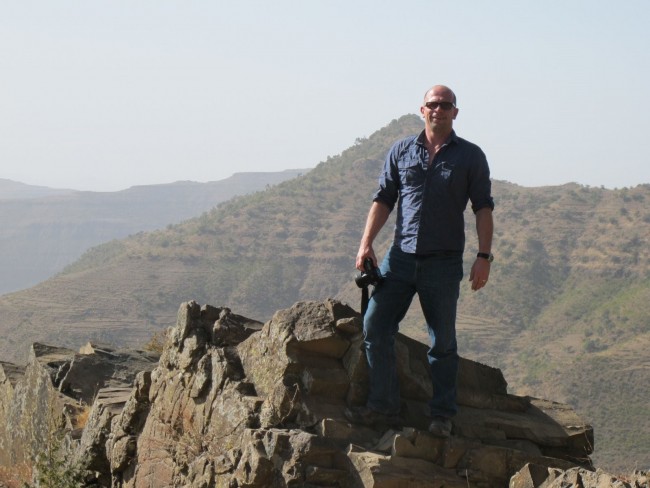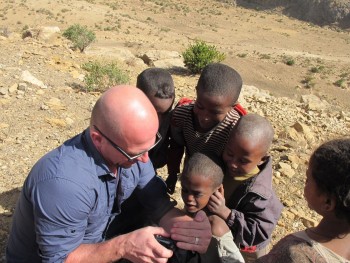Scientist Profile: Thorsten Becker
October 12, 2016

By John Holden
Cross-collaboration may be all the rage in academia these days, but Thorsten Becker has embodied this approach to research his entire career. At the expense of being considered a ‘Jack of all trades but master of none’, he has pursued interests in geodynamics, fault dynamics, seismology and high-performance computing, regardless of any perceived labels.
It doesn’t seem to have done damage to his career. His research has led him across the globe to Japan, Morocco, Ethiopia, Italy, Colombia, his homeland Germany, and most recently, Southern California. Becker’s openness to outside influences is one of the reasons why he has been drawn towards the Lone Star State to take up the position of Shell Distinguished Chair of Geophysics at the The University of Texas at Austin’s Jackson School of Geosciences. Becker, who started at the school in summer 2016, holds the position in the Department of Geological Sciences as well as a position as a researcher at the University of Texas Institute for Geophysics (UTIG).
“My expertise in structural seismology, geodynamics, computing and fault dynamics means I fit in between a lot of other people here,” he said. “I’m hoping that will give me the chance to facilitate cutting-edge research.”
Becker’s appointment was announced as the Jackson School works to promote interdisciplinary research and implement initiatives to foster transformative research at the interfaces between traditional scientific disciplines.
“Recruiting Thorsten was a tremendous coup for the Jackson School,” explained Professor Richard Ketcham, associate dean for academic affairs at the Jackson School. “He is an internationally famous geodynamicist whose star is still ascending. It’s clear that he will bring extraordinary energy to our faculty.”
Becker will help create a new lithospheric dynamics group that will bring together faculty, research scientists and students across a range of fields to use an interdisciplinary approach to attack questions spanning the crust and upper mantle.
“We expect that this will create a dynamic environment that will push forward Jackson School research while giving our students’ education a new dimension,” Ketcham said.
“The University
of Texas in
Austin is a great
place where you
can do things
you simply
couldn’t do
anywhere else.”
-Thorsten Becker
Things are being shaken up on a more basic level, too. UTIG is already in the process of reconfiguring office space to bring people with similar research interests closer together, and the department has similar plans.
Becker believes his skills will fit in well with the school’s push to increase interaction
between research disciplines.
“I tend to work collaboratively, mainly because I don’t have any good ideas of my own,” he said with a laugh. “There are different ways of conducting science. I’ve
written a number of papers as a single author, but I’ve completed many more in groups. At the University of Southern California, where I just moved from, I wrote papers with nine different faculty.”
For Becker, collaboration is the fun part because it allows researchers to gain expertise across disciplines and provides greater context to the research.
“There’s an academic model where the single faculty builds its little empire, which is really high and impressive,” he said. “But it has a big wall around it. I’m not that guy. Answering some of the bigger, more fundamental questions which we face will, I believe, require much greater collaboration.”
Becker’s openness is reflected in his research. A physicist by training, he got his master’s in physics from Frankfurt University in 1997, which included a geophysics-focused thesis.
“I was interested in pursuing non-linear dynamics, chaos, stuff like that, but changed my mind after taking a field class that involved doing applied geophysics measurements outdoors,” he said. “I thought, ‘wouldn’t it be great to be able to combine my love of physics with being outdoors?’”
Despite his love of the outdoors, Becker spent the following 15 years indoors mainly focused on computer modelling.
“It’s only recently that I’ve been able to go back to why I got into geophysics in the first place,” he said. “I got a Ph.D. at Harvard and started working on upper-mantle geodynamics, and ever since I’ve been focused on mantle dynamics, but always with some earthquake research on the side.”
In order to cover all bases, his approach in the past has been to assign one student with a fault line problem while the rest of the group looks at how plate tectonics works and how deep-mantle dynamics is expressed at the surface.
“That is how I’ll be able to bring field observations in at UT,” he added. “I’m going to be
running both computational modelling programs and a structural seismology program.”
Becker’s “earthquake research on the side” has become more than a hobby and demonstrates once again his desire to look at his discipline as more than the sum of its parts.
“I’m fascinated by how the mantle talks to the surface,” he said. “How do you go from a 1 million year time-scale deformation to the shorter term, 100 year time-scale seismic cycle? How does the long term plate motion work itself into earthquakes?”
The Jackson School was the only place where he believes there is enough critical mass in terms of research expertise to be able to answer the big questions.
“The University of Texas in Austin is a great place where you can do things you simply couldn’t do anywhere else,” he said. “It has such a wide range of specialist research and, given my interest in transitions and how the mantle talks to
the surface, this is the only place to be. Here there are experts who legitimately cross the entire research range—erosion, hydrology, tectonics, faulting, dating of the uplift, etcetera. There are so many great people here. I’m just looking forward to being in the middle of all of that.”

After completing his Master of Science in physics from the J.W. Goethe University in Frankfurt in 1997, Thorsten went to Harvard to obtain a Ph.D. in geophysics, which he completed in 2002. He spent the following two years as a postdoctoral scholar at the IGPP Scripps Institution of Oceanography, based at the University of California, San Diego. He now joins the Jackson School of Geosciences after spending the past 12 years at the University of Southern California where he was professor of Earth Sciences. His research has also led him into a number of visiting appointments, including ones at the University of Tokyo, Universitá di Roma TRE, Princeton and GFZ Potsdam.
Back to the Newsletter